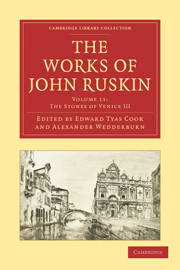Book contents
- Frontmatter
- Contents
- LIST OF ILLUSTRATIONS
- INDEX TO THE ILLUSTRATIONS
- INTRODUCTION TO THIS VOLUME
- BIBLIOGRAPHICAL NOTE
- THE STONES OF VENICE
- THIRD, OR RENAISSANCE PERIOD
- CHAP. I EARLY RENAISSANCE
- CHAP. II ROMAN RENAISSANCE
- CHAP. III GROTESQUE RENAISSANCE
- CHAP. IV CONCLUSION
- EPILOGUE—“CASTEL-FRANCO”
- AUTHOR'S APPENDIX
- Examples of the Architecture of Venice
- Venetian Index
- Plate section
CHAP. I - EARLY RENAISSANCE
from THIRD, OR RENAISSANCE PERIOD
Published online by Cambridge University Press: 07 September 2011
- Frontmatter
- Contents
- LIST OF ILLUSTRATIONS
- INDEX TO THE ILLUSTRATIONS
- INTRODUCTION TO THIS VOLUME
- BIBLIOGRAPHICAL NOTE
- THE STONES OF VENICE
- THIRD, OR RENAISSANCE PERIOD
- CHAP. I EARLY RENAISSANCE
- CHAP. II ROMAN RENAISSANCE
- CHAP. III GROTESQUE RENAISSANCE
- CHAP. IV CONCLUSION
- EPILOGUE—“CASTEL-FRANCO”
- AUTHOR'S APPENDIX
- Examples of the Architecture of Venice
- Venetian Index
- Plate section
Summary
§ 1. I trust that the reader has been enabled by the preceding chapters, to form some conception of the magnificence of the streets of Venice during the course of the thirteenth and fourteenth centuries. Yet by all this magnificence she was not supremely distinguished above the other cities of the Middle Ages. Her early edifices have been preserved to our times by the circuit of her waves; while continual recurrences of ruin have defaced the glory of her sister cities. But such fragments as are still left in their lonely squares, and in the corners of their streets, so far from being inferior to the buildings of Venice, are even more rich, more finished, more admirable in invention, more exuberant in beauty. And although, in the North of Europe, civilisation was less advanced, and the knowledge of the arts was more confined to the ecclesiastical orders, so that, for domestic architecture, the period of perfection must be there placed much later than in Italy, and considered as extending to the middle of the fifteenth century; yet, as each city reached a certain point in civilisation, its streets became decorated with the same magnificence, varied only in style according to the materials at hand, and temper of the people. And I am not aware of any town of wealth and importance in the Middle Ages, in which some proof does not exist that, at its period of greatest energy and prosperity, its streets were inwrought with rich sculpture, and even (though in this, as before noticed, Venice always stood supreme) glowing with colour and with gold.
- Type
- Chapter
- Information
- The Works of John Ruskin , pp. 3 - 42Publisher: Cambridge University PressPrint publication year: 2010First published in: 1904



